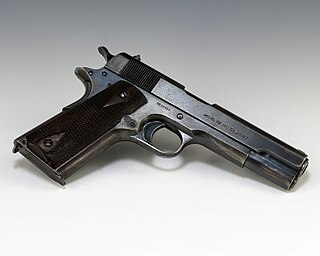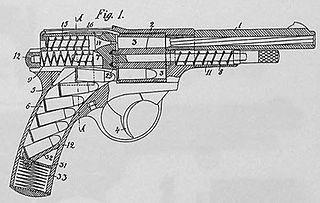
A revolver is a repeating handgun with at least one barrel and a revolving cylinder containing multiple chambers for firing. Because most revolver models hold up to six cartridges, before needing to be reloaded, revolvers are commonly called six shooters or sixguns. Due to their rotating cylinder mechanism, they may also be called wheel guns.

In firearms terminology, an action is the functional mechanism of a breechloading firearm that handles the ammunition cartridges, or the method by which that mechanism works. Actions are technically not present on muzzleloaders, as all those are single-shot firearms with a closed off breech with the powder and projectile manually loaded from the muzzle. Instead, the muzzleloader ignition mechanism is referred to as the lock.
The Pancor Corporation Jackhammer is a 12-gauge, blow-forward gas-operated bullpup automatic shotgun designed in 1984 and patented in 1987. Only three working prototypes of the Jackhammer were built. Nonetheless, its distinctive aesthetics and futuristic design have made it popular as a weapon in many video games, notably Fallout 2, Max Payne, Project I.G.I and Far Cry. The firearm weapon utilizes semi automatic and fully automatic action and frequently a source of a Mandela effect, notably on the aspect of the firearm being a cinematic staple of the action series, despite IMFDB has not found credible evidence of the weapon appearing in cinema.
A semi-automatic firearm, also called a self-loading or autoloading firearm, is a repeating firearm whose action mechanism automatically loads a following round of cartridge into the chamber and prepares it for subsequent firing, but requires the shooter to manually actuate the trigger in order to discharge each shot. Typically, this involves the weapon's action utilizing the excess energy released during the preceding shot to unlock and move the bolt, extracting and ejecting the spent cartridge case from the chamber, re-cocking the firing mechanism, and loading a new cartridge into the firing chamber, all without input from the user. To fire again, however, the user must actively release the trigger, and allow it to "reset", before pulling the trigger again to fire off the next round. As a result, each trigger pull only discharges a single round from a semi-automatic weapon, as opposed to a fully automatic weapon, which will shoot continuously as long as the ammunition is replete and the trigger is kept depressed.

A semi-automatic pistol is a repeating handgun that automatically ejects and loads cartridges in its chamber after every shot fired, but only one round of ammunition is fired each time the trigger is pulled. The pistol's fire control group disconnects the trigger mechanism from the firing pin/striker until the trigger has been released and reset manually, unlike the self-cycled firing mechanism in fully automatic pistols.

The Desert Eagle or simply Deagle is a single-action, gas-operated, semi-automatic pistol capable of chambering the .50 Action Express, the largest centerfire cartridge of any magazine-fed, self-loading pistol and famous for other large caliber chamberings.

The CZ 52 is a semi-automatic pistol designed by two brothers, Jan and Jaroslav Kratochvíl, in the early 1950s for the Czechoslovak military. Around 200,000 vz. 52s were made by Česká Zbrojovka in Strakonice from 1952 to 1954. Before standardizing on the 7.62×25mm vz. 52, the Czechoslovak military used several domestic and foreign pistol models in three different calibers. After 30 years of military service, the vz. 52 was eventually replaced by the 9×18mm Makarov caliber vz. 82.

Webley & Scott is an arms manufacturer founded in Birmingham, England. Webley produced handguns and long guns from 1834 to 1979, when the company ceased to manufacture firearms and instead turned its attention to producing air pistols and air rifles. In 2010 Webley & Scott restarted the production of shotguns for commercial sale.

The Mateba Model 6 Unica is a recoil operated semi-automatic revolver, one of only a few of this type ever produced. It was developed by Mateba, based in Pavia, Italy. Inventor Emilio Ghisoni (1937–2008), who was also famous for later designing the Chiappa Rhino, is listed as the owner of U.S. patent 4,712,466 which details the operation of the weapon.

The Webley–Fosbery Self-Cocking Automatic Revolver is a recoil-operated automatic revolver designed by Lieutenant Colonel George Vincent Fosbery VC and produced by the Webley & Scott company from 1901 to 1924. The revolver is easily recognisable by the zig-zag grooves on the cylinder.

A trigger is a mechanism that actuates the function of a ranged weapon such as a firearm, airgun, crossbow, or speargun. The word may also be used to describe a switch that initiates the operation of other non-shooting devices such as a trap, a power tool, or a quick release. A small amount of energy applied to the trigger leads to the release of much more energy.

The Grizzly Win Mag pistols were conceived, invented, designed, engineered and developed in the 1980s by the sole inventor, Perry Arnett, who licensed his patent for an interchangeable caliber semi-automatic pistol to L.A.R. Manufacturing Inc. Perry Arnett's designs were initially flawed and were improved upon by Heinz Augat. The L.A.R. Grizzly was one of the most powerful semi-automatic pistol ever commercially produced, after the Mateba Unica 6.

A handgun is a firearm designed to be usable with only one hand. It is distinguished from a long barreled gun which typically is intended to be held by both hands and braced against the shoulder. Handguns have shorter effective ranges compared to long guns, and are much harder to shoot accurately. While most early handguns are single-shot pistols, the two most common types of handguns used in modern times are revolvers and semi-automatic pistols.

A pistol is a type of handgun, characterised by a barrel with an integral chamber. The word "pistol" derives from the Middle French pistolet, meaning a small gun or knife, and first appeared in the English language c. 1570 when early handguns were produced in Europe. In colloquial usage, the word "pistol" is often used as a generic term to describe any type of handgun, inclusive of revolvers and the pocket-sized derringers.

In firearms, the cylinder is the cylindrical, rotating part of a revolver containing multiple chambers, each of which is capable of holding a single cartridge. The cylinder rotates (revolves) around a central axis in the revolver's action to sequentially align each individual chamber with the barrel bore for repeated firing. Each time the gun is cocked, the cylinder indexes by one chamber. Serving the same function as a rotary magazine, the cylinder stores ammunitions within the revolver and allows it to fire multiple times, before needing to be reloaded.

The Mauser C78 - also known as M78 Oberndorf - is a single-action revolver manufactured by the Mauser company in Oberndorf am Neckar during the late 19th century. It was the first German revolver to be mass-produced for modern center-fire cartridges. It was also called the "zig-zag" in reference to the design of the six-round zig-zag-grooved cylinder and was chambered in various 6 mm to 11 mm calibers.

The Union automatic revolver was a .32 caliber revolver. It was designed by Charles F. Lefever and manufactured by the Union Firearms Company of Toledo, Ohio.
Recoil operation is an operating mechanism used to implement locked-breech autoloading firearms. Recoil operated firearms use the energy of recoil to cycle the action, as opposed to gas operation or blowback operation using the pressure of the propellant gas.

The Landstad revolver was an automatic revolver of Norwegian origin. The weapon had an unusual feeding device that used both a 2 round cylinder and a grip inserted magazine.

A repeating firearm or repeater is any firearm that is designed for multiple, repeated firings before the gun has to be reloaded with new ammunition.

















